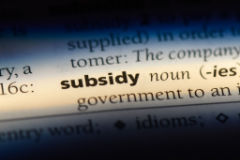What is a subsidy and how do tax subsidies work?
At a glance
A subsidy is a benefit offered to an individual or group, usually from a governing body. They can come in the form of direct payments, like a cash payment, or indirect payments like a tax credit.
You may have come across the word subsidy as part of insurance information or even in the news, but it might be an unfamiliar term. So, what is a subsidy? Essentially, it’s a payment to individuals from the government, usually in the form of a targeted tax cut.
Subsidies are given in the United States to help relieve some sort of financial weight or burden and are generally intended to be in the public’s interest by promoting a social good or economic policy.

While subsidies are generally available to businesses, there are also a few subsidies out there for individuals. A common type is a tax subsidy, which is an indirect payment from the government. There are other types, like direct subsidies, which are cash payments, and aren’t offered through tax expenditures.
Some people refer to these as tax subsidies, and one subset of these is known as tax credits. We may use both terms as we discuss this topic. (Other types of tax subsidies include alterations to a tax rate or exempting entities from tax.)
You might know that tax subsidies are out there representing financial support, but you don’t know precisely how they work and how to access them. This post will walk you through the specifics of tax subsidies for individuals.
Ready to tackle how subsidies work? First, you should know it depends on the type. In fact, there are many different subsidies available to individuals and businesses.
Health insurance subsidies
If you’re wondering, “What is a subsidy in health insurance?”, we’ve got more insight. Here are a couple tax credits that people think of as government subsidies:
Premium Tax Credit (Individual PTC Health Insurance Subsidy)
The Premium Tax Credit, otherwise known as the Individual PTC, is a tax credit that helps make certain health care insurance coverage (premiums) more affordable. You’ll receive it as a refundable credit on your tax return. So, even if you owe little or no tax, you can still benefit from the credit by getting a larger tax refund.
Advanced Premium Tax Credit (APTC Subsidy)
This advance tax credit is based on your estimated household income at the time you sign up for Marketplace insurance. It’s paid directly to your insurance provider each month and helps with the premium you pay out of pocket.
When you file your tax return, you compare your advance credit based on estimated income to the credit you qualify to claim with your actual income.
Do I qualify for a subsidy or tax credit?
Not everyone qualifies for an individual government tax credit for healthcare in the United States. At a high level, you must qualify to purchase and use the government-sponsored health insurance Marketplace.
Discover if you qualify for subsidies like the Premium Tax Credit or Advanced Premium Tax Credit.
How do subsidies affect income taxes?
When you file your taxes, the amount of your credit you can take is determined by your adjusted gross income and income tax filing status.
There are a few things to keep in mind with the APTC subsidy:
- If the tax subsidy is the same as the amount paid to your insurance on your behalf, there is no impact on your taxes.
- If you increased your income within the tax year, you may have received a larger credit than what you should have. In this case, you need to pay back a portion or all of the money you received from the government.
- If you earned less income than estimated, you may be entitled to a higher tax subsidy. If this is the case, you’ll get a refund that will be applied to your tax return.
How to file taxes with a tax subsidy
If you, your spouse, or dependents claim a healthcare tax subsidy, you must notate it on your taxes. To do this attach Form 8962 to your individual tax return. Attaching the form can help you avoid your return being rejected when you e-file (shown as Reject Code F8962-070).
To help you complete Form 8962, the health insurance exchange will send you an informational tax return via Form 1095-A. Can’t find your Form 1095-A? You can get a copy from www.healthcare.gov or your state’s exchange portal if you received coverage from a state exchange.
Claiming tax subsidies on your return? Turn to H&R Block for help
Interested in claiming tax credits like the healthcare-specific federal government subsidies as listed above?
You can rely on H&R Block to help navigate you through everything from tax preferences, incentives, and benefits to tax breaks. Learn about the ways to file taxes with H&R Block.
Was this topic helpful?
